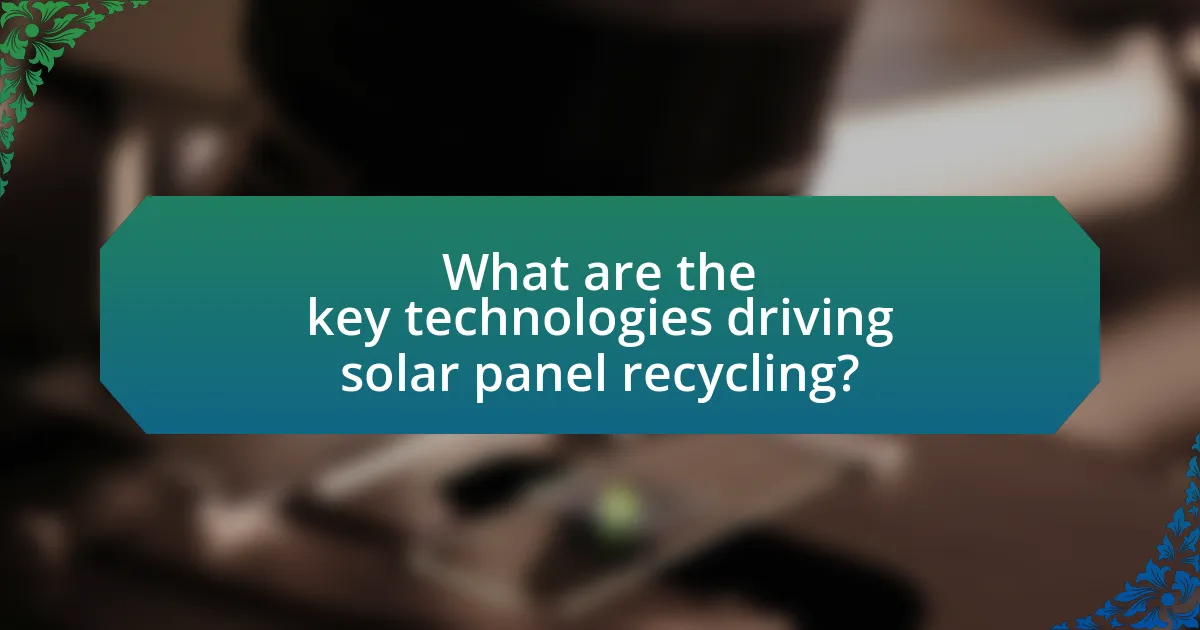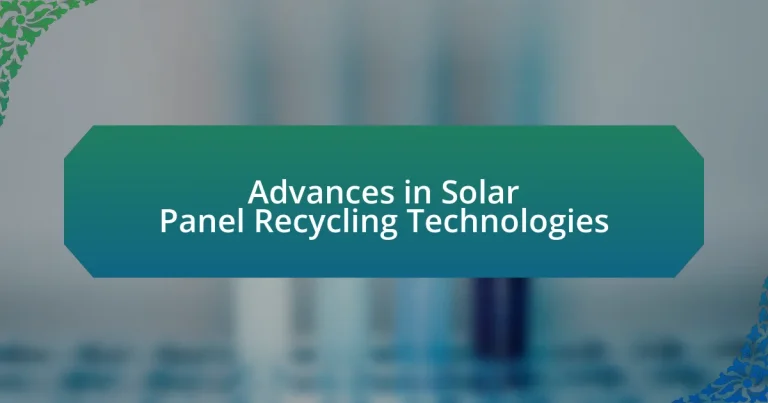Advances in solar panel recycling technologies focus on improving the efficiency of recovering valuable materials such as silicon, silver, and rare metals from end-of-life solar panels. Recent innovations, including mechanical and hydrometallurgical processes, have achieved material recovery rates exceeding 90%, significantly enhancing economic viability and sustainability. The article explores the evolution of recycling methods, historical practices, recent innovations, and the environmental impacts of solar panel waste. It also discusses the role of automation, regulatory changes, and best practices for companies to ensure effective recycling and compliance with emerging international standards.

What are Advances in Solar Panel Recycling Technologies?
Advances in solar panel recycling technologies include the development of more efficient methods for recovering valuable materials such as silicon, silver, and rare metals from end-of-life solar panels. Recent innovations involve mechanical processes combined with chemical treatments that enhance material recovery rates, achieving over 90% efficiency in some cases. For instance, a study published in the journal “Renewable and Sustainable Energy Reviews” highlights a new hydrometallurgical approach that significantly reduces energy consumption and environmental impact compared to traditional recycling methods. These advancements not only improve the economic viability of recycling but also support sustainability efforts by reducing waste and promoting the circular economy in the solar industry.
How have recycling technologies evolved in the solar panel industry?
Recycling technologies in the solar panel industry have significantly advanced to improve material recovery and reduce environmental impact. Innovations such as hydrometallurgical processes and mechanical separation techniques have emerged, allowing for the efficient extraction of valuable materials like silicon, silver, and glass from end-of-life solar panels. For instance, a study published in the journal “Renewable and Sustainable Energy Reviews” highlights that these methods can recover up to 95% of the materials, compared to traditional methods that were less effective. Additionally, the development of automated systems for disassembly and sorting has streamlined the recycling process, making it more cost-effective and scalable. These advancements reflect a growing commitment to sustainability and resource efficiency within the solar energy sector.
What historical methods were used for solar panel recycling?
Historical methods for solar panel recycling primarily included mechanical processes, thermal treatment, and chemical leaching. Mechanical processes involved dismantling solar panels to recover materials like glass and metals, while thermal treatment utilized high temperatures to separate components. Chemical leaching employed solvents to extract valuable materials such as silicon and metals from the panel’s structure. These methods laid the groundwork for more advanced recycling technologies by demonstrating the feasibility of recovering materials from end-of-life solar panels.
What recent innovations have emerged in solar panel recycling?
Recent innovations in solar panel recycling include the development of advanced mechanical and chemical processes that enhance the recovery of valuable materials. For instance, researchers have introduced a new method that utilizes a combination of thermal and chemical treatments to efficiently extract silicon, silver, and other metals from discarded panels. This process not only increases material recovery rates but also reduces energy consumption compared to traditional recycling methods. Additionally, companies are implementing automated sorting technologies that improve the efficiency of separating different components of solar panels, leading to higher purity levels in recovered materials. These advancements are crucial as the solar industry faces a growing need for sustainable recycling solutions, with an estimated 78 million metric tons of solar panel waste expected by 2050, according to the International Renewable Energy Agency.
Why is solar panel recycling important?
Solar panel recycling is important because it mitigates environmental hazards and conserves valuable materials. As solar panels reach the end of their lifespan, typically around 25 to 30 years, improper disposal can lead to toxic substances, such as cadmium and lead, leaching into the environment. Recycling processes can recover up to 95% of the materials used in solar panels, including silicon, glass, and metals, which can then be reused in new products. This not only reduces the demand for raw materials but also minimizes the carbon footprint associated with mining and manufacturing.
What environmental impacts are associated with solar panel waste?
Solar panel waste poses significant environmental impacts, primarily due to the presence of hazardous materials such as cadmium, lead, and other toxic substances. When solar panels are improperly disposed of, these materials can leach into soil and groundwater, leading to contamination and potential health risks for humans and wildlife. According to a study by the International Renewable Energy Agency, the global solar panel waste could reach 78 million metric tons by 2050 if recycling measures are not implemented effectively. This underscores the urgency for advancements in recycling technologies to mitigate these environmental risks.
How does recycling contribute to sustainability in the solar industry?
Recycling contributes to sustainability in the solar industry by reducing waste and conserving resources. When solar panels reach the end of their life cycle, recycling processes recover valuable materials such as silicon, glass, and metals, which can be reused in the production of new panels. This not only minimizes the environmental impact associated with mining and manufacturing new materials but also decreases landfill waste. According to a study by the International Renewable Energy Agency, recycling can recover up to 95% of the materials in solar panels, significantly enhancing the circular economy within the solar sector.

What are the key technologies driving solar panel recycling?
The key technologies driving solar panel recycling include mechanical processing, hydrometallurgical methods, and thermal treatment. Mechanical processing involves the physical dismantling of solar panels to separate materials such as glass, metals, and polymers, which can then be reused. Hydrometallurgical methods utilize chemical solutions to extract valuable metals like silver and copper from the solar cells, enhancing recovery rates. Thermal treatment, often referred to as pyrolysis, involves heating materials to high temperatures to break down complex compounds, allowing for the recovery of silicon and other materials. These technologies collectively improve the efficiency and effectiveness of recycling processes, addressing the growing need for sustainable waste management in the solar industry.
How do mechanical recycling methods work?
Mechanical recycling methods work by physically processing materials to recover valuable components without altering their chemical structure. In the context of solar panel recycling, these methods typically involve disassembling the panels, shredding the materials, and separating the different components such as glass, metals, and polymers. For instance, a study by the International Renewable Energy Agency (IRENA) highlights that mechanical recycling can recover up to 95% of the glass and 90% of the metals from solar panels, demonstrating its efficiency in resource recovery.
What are the advantages of mechanical recycling for solar panels?
Mechanical recycling for solar panels offers several advantages, including resource recovery, reduced environmental impact, and cost-effectiveness. This method allows for the extraction of valuable materials such as silicon, silver, and glass, which can be reused in new solar panel production or other applications. By recovering these materials, mechanical recycling minimizes the need for virgin resources, thereby conserving natural resources and reducing energy consumption associated with mining and processing. Additionally, mechanical recycling processes typically generate less waste and lower emissions compared to other recycling methods, contributing to a more sustainable waste management solution for end-of-life solar panels. Studies indicate that mechanical recycling can recover up to 95% of the materials in solar panels, demonstrating its efficiency and effectiveness in promoting a circular economy within the solar industry.
What limitations exist in mechanical recycling processes?
Mechanical recycling processes face several limitations, including material degradation, contamination, and limited recovery rates. These processes often result in a reduction of the quality of recycled materials due to thermal and mechanical stress, which can compromise their structural integrity. Contamination from non-recyclable materials can hinder the efficiency of the recycling process, leading to lower purity levels in the recovered materials. Additionally, recovery rates for certain materials, such as rare metals found in solar panels, can be significantly low, often below 50%, making it economically unfeasible to recycle them effectively.
What role do chemical recycling methods play?
Chemical recycling methods play a crucial role in the recycling of solar panels by enabling the recovery of valuable materials such as silicon, metals, and glass. These methods utilize chemical processes to break down complex materials into their constituent parts, which can then be reused in the production of new solar panels or other products. For instance, studies have shown that chemical recycling can achieve recovery rates of over 90% for certain materials, significantly enhancing the sustainability of solar energy technologies. This high recovery efficiency not only reduces waste but also minimizes the need for virgin materials, thereby lowering the environmental impact associated with solar panel production.
How do chemical processes improve material recovery rates?
Chemical processes enhance material recovery rates by facilitating the efficient separation and extraction of valuable components from solar panels. These processes, such as hydrometallurgy and pyrolysis, utilize chemical reactions to break down complex materials, allowing for the recovery of metals like silver, silicon, and indium. For instance, research indicates that hydrometallurgical methods can achieve recovery rates exceeding 90% for silver from used solar cells, significantly improving the overall efficiency of recycling operations.
What challenges are faced in implementing chemical recycling?
Implementing chemical recycling faces several challenges, including high operational costs, technological limitations, and regulatory hurdles. High operational costs arise from the need for advanced technologies and infrastructure, which can deter investment. Technological limitations include the efficiency of current chemical recycling processes, which may not effectively handle all types of plastics or materials found in solar panels. Regulatory hurdles involve navigating complex environmental regulations that can vary by region, complicating the establishment of chemical recycling facilities. These challenges hinder the widespread adoption of chemical recycling methods in the solar panel recycling sector.

What are the future trends in solar panel recycling technologies?
Future trends in solar panel recycling technologies include the development of more efficient and cost-effective recycling processes, such as hydrometallurgical methods that recover valuable materials like silicon, silver, and rare metals with minimal environmental impact. Innovations in automated sorting and disassembly technologies are also emerging, enabling faster processing of end-of-life panels. Research indicates that by 2030, the global solar panel recycling market could reach $2 billion, driven by increasing regulatory pressures and the need for sustainable waste management solutions. These advancements aim to enhance material recovery rates and reduce the carbon footprint associated with solar panel disposal.
How is automation influencing solar panel recycling?
Automation is significantly enhancing the efficiency and effectiveness of solar panel recycling processes. Automated systems streamline the dismantling of solar panels, allowing for the rapid separation of valuable materials such as silicon, glass, and metals. For instance, advanced robotic technologies can identify and extract components with precision, reducing labor costs and minimizing human error. According to a study by the International Renewable Energy Agency, automated recycling methods can increase recovery rates of materials from solar panels by up to 95%, compared to traditional manual processes. This not only improves the economic viability of recycling but also supports sustainability efforts by ensuring that valuable resources are reused rather than disposed of.
What technologies are being developed to enhance efficiency?
Technologies being developed to enhance efficiency in solar panel recycling include advanced mechanical separation techniques, chemical recycling processes, and innovative materials recovery systems. Advanced mechanical separation techniques utilize specialized machinery to efficiently separate glass, metals, and semiconductor materials from used solar panels, improving recovery rates. Chemical recycling processes involve the use of solvents and reagents to dissolve and extract valuable materials like silicon and silver from solar cells, which can lead to higher purity and yield. Innovative materials recovery systems are designed to optimize the extraction of rare materials, such as indium and tellurium, which are critical for high-efficiency solar cells. These advancements are supported by research indicating that improved recycling methods can recover up to 95% of materials from solar panels, significantly reducing waste and enhancing sustainability in the solar industry.
How might AI and machine learning be integrated into recycling processes?
AI and machine learning can be integrated into recycling processes by enhancing sorting accuracy and optimizing operational efficiency. For instance, machine learning algorithms can analyze images of waste materials to identify and classify different types of recyclables, significantly improving the sorting process. According to a study published in the journal “Waste Management,” AI-driven systems can achieve up to 95% accuracy in identifying recyclable materials, compared to traditional methods that often fall below 70%. Additionally, AI can optimize logistics and processing schedules, reducing energy consumption and costs associated with recycling operations. This integration not only streamlines the recycling process but also increases the overall recovery rates of valuable materials, such as those found in solar panels.
What regulatory changes are impacting solar panel recycling?
Regulatory changes impacting solar panel recycling include the implementation of extended producer responsibility (EPR) laws and stricter waste management regulations. EPR laws require manufacturers to take responsibility for the entire lifecycle of their products, including end-of-life disposal and recycling, which incentivizes the development of more sustainable recycling practices. For instance, the European Union’s Waste Electrical and Electronic Equipment (WEEE) Directive mandates that producers finance the collection, treatment, and recycling of solar panels, aiming to reduce landfill waste and promote resource recovery. Additionally, various states in the U.S. are adopting similar regulations, which are expected to increase recycling rates and improve the overall sustainability of solar energy systems.
How do government policies affect recycling practices?
Government policies significantly influence recycling practices by establishing regulations, incentives, and funding that promote or hinder recycling efforts. For instance, policies such as mandatory recycling laws and extended producer responsibility (EPR) frameworks compel manufacturers to manage the lifecycle of their products, including end-of-life recycling. In 2020, the European Union implemented the Waste Electrical and Electronic Equipment (WEEE) Directive, which mandates that producers finance the collection and recycling of electronic waste, thereby increasing recycling rates. Additionally, financial incentives like tax credits for recycling facilities can enhance investment in recycling technologies, leading to advancements in processes such as solar panel recycling. These policies create a structured environment that encourages both consumers and businesses to engage in recycling, ultimately improving overall recycling rates and sustainability outcomes.
What international standards are emerging for solar panel recycling?
Emerging international standards for solar panel recycling include the IEC 62977 series and the WEEE Directive in Europe. The IEC 62977 series provides guidelines for the recycling of photovoltaic modules, focusing on material recovery and environmental impact. The WEEE Directive mandates the proper disposal and recycling of electronic waste, including solar panels, to minimize landfill use and promote resource recovery. These standards aim to enhance sustainability in the solar industry by establishing protocols for the safe and efficient recycling of solar panels, thereby addressing the growing concern of waste management as solar energy adoption increases.
What best practices should companies adopt for effective solar panel recycling?
Companies should adopt a systematic approach to solar panel recycling that includes establishing take-back programs, collaborating with certified recycling facilities, and implementing transparent tracking systems. Take-back programs encourage consumers to return end-of-life panels, ensuring proper disposal and recycling. Collaborating with certified recycling facilities guarantees that the recycling process adheres to environmental regulations and maximizes material recovery. Implementing tracking systems allows companies to monitor the recycling process and ensure accountability, which is crucial for compliance and sustainability. According to the International Renewable Energy Agency, effective recycling can recover up to 95% of materials from solar panels, highlighting the importance of these best practices in promoting a circular economy.
How can companies ensure compliance with recycling regulations?
Companies can ensure compliance with recycling regulations by implementing a comprehensive waste management plan that aligns with local, state, and federal laws. This involves regularly reviewing and updating their recycling policies to reflect current regulations, conducting employee training on proper recycling practices, and maintaining accurate records of recyclable materials processed. For instance, the Environmental Protection Agency (EPA) provides guidelines that companies can follow to meet regulatory requirements, ensuring that they are not only compliant but also contributing to sustainable practices in the solar panel recycling industry.
What strategies can enhance the efficiency of recycling operations?
Implementing automated sorting technologies can significantly enhance the efficiency of recycling operations. Automation reduces human error and increases processing speed, allowing for more precise separation of materials. For instance, advanced optical sorting systems can identify and sort different types of plastics and metals with over 95% accuracy, leading to higher recovery rates. Additionally, optimizing logistics through better route planning and scheduling can minimize transportation costs and time, further improving operational efficiency. Studies have shown that integrating these strategies can lead to a 20-30% increase in overall recycling efficiency, demonstrating their effectiveness in enhancing recycling operations.




